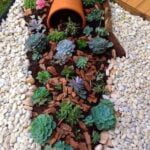Are you looking for some fresh vegetable gardening ideas to amp up your garden this season? Whether you are a seasoned gardener or just starting out with your very first vegetable garden, there are always new and innovative ways to enhance your gardening experience. From selecting the right vegetables to harvesting and preserving your produce, there are many aspects to consider when it comes to successful vegetable gardening.
When it comes to vegetable gardening ideas, the possibilities are endless. You can explore a variety of techniques and methods to make the most of your garden space and resources. In this article, we will explore different aspects of vegetable gardening, from choosing the right vegetables for your garden to creative ideas for vertical and container gardening. We’ll also cover important topics such as soil preparation, watering, pest management, and harvesting and preserving your garden produce.
In this comprehensive guide, we will delve into key topics such as planning and designing your vegetable garden, best practices for soil preparation and fertilization, tips for watering and maintenance of your garden, creative ideas for vertical and container gardening, pest and disease management, as well as harvesting and preserving your garden produce. By the end of this article, you will have a wealth of knowledge at hand to create a thriving and fruitful vegetable garden of your own.
Get ready to roll up your sleeves and dive into the world of vegetable gardening.
Choosing the Right Vegetables for Your Garden
When it comes to starting a vegetable garden, choosing the right vegetables is crucial for a successful harvest. There are several factors to consider when deciding which vegetables to grow in your garden, including climate, sunlight, and available space.
One important factor to consider when choosing vegetables for your garden is your local climate and growing season. Some vegetables thrive in cooler temperatures, while others require heat and sun. It’s essential to research the specific needs of the vegetables you want to grow and ensure they are suitable for your climate.
Another consideration is the amount of sunlight your garden receives. Most vegetables require at least 6-8 hours of sunlight per day, so it’s important to choose vegetables that are well-suited to the amount of sunlight available in your garden.
Finally, consider the space you have available for your vegetable garden. If you have limited space, you may want to focus on growing compact or dwarf varieties of vegetables or consider vertical gardening techniques.
| Factor | Consideration |
|---|---|
| Local Climate | Research specific needs of chosen vegetables |
| Amount of Sunlight | Most veggies need at least 6-8 hours of sun daily |
| Available Space | Consider compact or dwarf varieties or vertical gardening techniques if space is limited |
Planning and Designing Your Vegetable Garden
When planning and designing your vegetable garden, it’s important to consider the layout and arrangement of your plants to ensure maximum growth and yield. Here are some tips for planning and designing your vegetable garden:
- Make a list of the vegetables you want to grow: Before you start planting, make a list of the vegetables you want to grow in your garden. Consider factors such as climate, soil type, and space availability when choosing which vegetables to plant.
- Decide on the layout of your garden: Consider the space available for your vegetable garden and plan the layout accordingly. You can opt for traditional rows, raised beds, or even square foot gardening. Each layout has its own advantages, so choose one that suits your needs.
- Companion planting: Consider companion planting when designing your vegetable garden. Some plants benefit from being planted near certain other plants, while others may inhibit each other’s growth. Research companion planting ideas to maximize the health and yield of your vegetables.
- Incorporate vertical gardening: Utilize vertical space in your vegetable garden by incorporating trellises, cages, or stakes for climbing plants like peas, tomatoes, cucumbers, and beans. This not only saves space but also creates an attractive visual element in your garden.
By carefully planning and designing your vegetable garden, you can create a productive and visually pleasing space that yields an abundant harvest. These ideas can help you create a well-designed vegetable garden that is both functional and attractive.
Best Practices for Soil Preparation and Fertilization
Soil preparation and fertilization are crucial steps in ensuring a successful vegetable garden. Before planting, it is important to test the pH level of your soil to determine its acidity or alkalinity. Most vegetables thrive in slightly acidic soil with a pH level between 6.0 and 7.0. If your soil’s pH is not within this range, you can adjust it by adding lime to raise the pH or sulfur to lower it.
Another best practice for soil preparation is to incorporate organic matter such as compost, well-rotted manure, or peat moss into the soil. This helps improve soil structure, drainage, and fertility. In addition, organic matter provides essential nutrients for the plants and encourages beneficial microbial activity in the soil.
When it comes to fertilization, it is recommended to use a balanced fertilizer that contains equal amounts of nitrogen, phosphorus, and potassium (N-P-K). The N-P-K ratio is usually indicated on the fertilizer packaging label. However, the specific fertilizer requirements may vary depending on the types of vegetables you are growing. For example, leafy greens may require more nitrogen for foliage growth, while root crops may benefit from higher phosphorus levels for root development.
It’s also important to follow the recommended application rates for fertilizers and avoid overfeeding your plants, as this can lead to nutrient imbalances and adversely affect plant health. Additionally, consider using natural or organic fertilizers that release nutrients slowly and promote long-term soil fertility. By following these best practices for soil preparation and fertilization, you can ensure that your vegetable garden has a nutrient-rich environment that supports healthy plant growth and bountiful harvests.
| Soil Preparation | Fertilization |
|---|---|
| Test pH level of soil | Use balanced fertilizer with N-P-K ratio |
| Incorporate organic matter into the soil | Follow recommended application rates |
| Adjust pH level if necessary | Consider natural or organic fertilizers |
Tips for Watering and Maintenance of Your Vegetable Garden
When it comes to vegetable gardening ideas, proper watering and maintenance are essential for the health and success of your garden. In this section, we will explore some tips and best practices to ensure that your vegetables thrive.
Watering
One of the most important aspects of vegetable gardening is ensuring that your plants receive the right amount of water. It’s crucial to water deeply and infrequently, rather than shallowly and frequently. This encourages the development of deeper roots, making your plants more resilient to dry periods. Consider installing a drip irrigation system or soaker hoses to deliver water directly to the root zone, reducing water waste through evaporation.
Maintenance
Regular maintenance is key to keeping your vegetable garden healthy and productive. This includes tasks such as weeding, mulching, and pruning. Weeding helps prevent competition for nutrients and water, while mulching conserves soil moisture and suppresses weeds. Pruning keeps plants in good shape and promotes air circulation, reducing the risk of disease.
Fertilizing
In addition to regular watering, fertilizing your vegetable garden is essential for promoting healthy growth and a bountiful harvest. Choose a balanced, organic fertilizer to provide necessary nutrients without causing harm to the environment or wildlife. Be sure to follow application instructions carefully and avoid over-fertilizing, which can lead to nutrient imbalances and damage to plants.
By implementing these watering and maintenance practices in your vegetable garden, you can enjoy a thriving and productive growing season with an abundance of fresh, delicious produce.
Creative Ideas for Vertical and Container Vegetable Gardening
Vertical and container vegetable gardening is a great option for individuals with limited space, such as those living in apartments or urban areas. It allows you to grow a variety of vegetables in a small area, utilizing vertical space and containers. Here are some creative ideas for vertical and container vegetable gardening:
- Vertical Gardening: Utilize trellises, stakes, and fences to grow vining vegetables such as tomatoes, cucumbers, and beans. This not only saves space but also makes harvesting easier.
- Container Gardening: Use containers such as pots, buckets, or even old tires to grow vegetables on patios, balconies, or any sunny spot. Make sure the containers have proper drainage and are large enough for the vegetables to thrive.
- Herb Towers: Create herb towers by stacking planters of different sizes on top of each other. This allows you to grow a variety of herbs in a small footprint.
These vegetable gardening ideas not only maximize space but also add visual interest to your garden. Additionally, they allow you to control the soil quality and minimize weed growth. Whether you’re growing vegetables in a small backyard or on a tiny balcony, vertical and container gardening offers endless possibilities.
Remember to choose compact varieties of vegetables that are well-suited for container gardening. Consider factors such as light requirements, water needs, and mature plant size when planning your vertical or container garden. With some creativity and careful planning, anyone can enjoy the rewards of vegetable gardening regardless of their available space.
Pest and Disease Management in Vegetable Gardens
Identifying Common Pests and Diseases
One of the key challenges in vegetable gardening is dealing with pests and diseases that can wreak havoc on your precious plants. Some common pests to watch out for include aphids, caterpillars, and snails, while diseases such as powdery mildew and blight are also common. It’s important to be able to identify these issues early on so that you can take action before they cause serious damage to your garden.
Natural Pest Control Methods
When it comes to pest management in vegetable gardens, many gardeners prefer to use natural and organic methods rather than relying on chemical pesticides. Some effective natural pest control methods include introducing beneficial insects such as ladybugs and lacewings, using companion planting techniques to repel pests, and applying organic sprays like neem oil. These methods not only help protect your plants from harm but also contribute to a healthier overall ecosystem in your garden.
Preventative Measures
In addition to dealing with pests and diseases after they appear, it’s also crucial to take preventative measures to minimize the likelihood of infestations or outbreaks. This includes practicing crop rotation, keeping the garden area clean and free of debris, regularly inspecting plants for signs of trouble, and providing proper spacing between plants for good air circulation. By being proactive in preventing pest and disease issues, you can greatly reduce the amount of effort required for management later on.
With these strategies for pest and disease management in mind, you can cultivate a thriving vegetable garden that is less susceptible to harm from external threats. Keeping a watchful eye on your plants, using natural control methods whenever possible, and taking preventative measures will help ensure the health and productivity of your vegetable garden for seasons to come.
Harvesting and Preserving Your Garden Produce
Once you have successfully grown your own vegetables in your garden, the next step is learning how to properly harvest and preserve your garden produce. Whether you have a small or large vegetable garden, knowing the best practices for harvesting and preserving can help you enjoy the fruits of your labor for a longer period of time.
When it comes to harvesting, it’s important to know when each type of vegetable is at its peak ripeness. This can vary depending on the specific vegetable, so it’s essential to do some research or consult with experienced gardeners.
Some vegetables are best harvested when they reach a certain size or color, while others are sweeter if left on the vine longer. Additionally, using sharp gardening shears or a knife will ensure that you don’t damage the plants during the harvesting process.
Once you have harvested your vegetables, proper preservation techniques will allow you to enjoy them beyond their growing season. Canning, freezing, and drying are popular methods for preserving garden produce. Canning involves sealing vegetables in jars with heat, while freezing allows for longer-term storage without compromising taste and texture.
Drying is another option that works well for herbs and some types of vegetables. By mastering these preservation methods, you can continue to savor the flavors of your homegrown vegetables throughout the year.
By taking the time to learn about proper harvesting and preservation techniques, you can maximize the benefits of your vegetable gardening efforts. From enjoying fresh produce straight from your garden during the growing season to having an abundance of preserved vegetables throughout the year, these practices allow you to fully enjoy the rewards of vegetable gardening.
Conclusion
In conclusion, vegetable gardening offers a multitude of benefits and rewards to those who take up the practice. Beyond the satisfaction of growing your own food, vegetable gardening allows individuals to cultivate a deeper connection with their food, develop new skills, promote environmental sustainability, and enjoy the physical and mental health benefits that come with spending time outdoors.
By incorporating a variety of vegetables into your garden, you can also diversify your diet and enjoy fresh produce throughout the growing season.
Furthermore, engaging in vegetable gardening encourages individuals to be more mindful of their food choices and consumption habits. This increased awareness often leads to a greater appreciation for the effort it takes to grow fruits and vegetables, reducing food waste and promoting more sustainable eating habits. Additionally, the act of tending to a garden can be incredibly therapeutic and provides an opportunity for individuals to relax and de-stress amidst the demands of daily life.
Overall, vegetable gardening is a fulfilling and rewarding endeavor that offers numerous benefits on both personal and societal levels. Whether you have ample outdoor space or just a small balcony, there are ample creative ideas for vertical and container vegetable gardening that can accommodate various living situations. So why not consider starting your own vegetable garden today? Embracing vegetable gardening can not only enrich your life but also contribute positively to our communities and the environment as a whole.

Welcome to my gardening blog! I am passionate about plants and enjoy sharing my knowledge and experiences with others. In this blog, I will write about everything related to gardening, from tips on how to get started to updates on my own garden projects.





